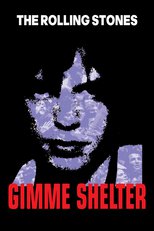 Gimme Shelter
(1970)
Gimme Shelter
(1970)
Below are links to reviews and further info from selected film sites. Links surrounded by a solid border lead directly to a page about this movie on that site. Links surrounded by a dashed border lead to a Google search for this exact movie title on that site. You may find it more efficient to open these links in separate browser tabs. Click Show More / All / Default to see more available links or return to the standard default selection. More (or fewer) choices of links can be selected via Options, and you can save your personal defaults (requires login).
This documentary of the Rolling Stones' 1969 US tour has become a legendary, harrowing symbol of the tragic demise of the "Peace and Love" era. After a successful tour across the US, the Rolling Stones gave a free December concert at Altamont Speedway in California with the Grateful Dead, Ike and Tina Turner, Jefferson Airplane, and the Flying Burrito Brothers. The band unwisely selected the Hells Angels to provide security, and the bikers resorted to violence to keep the stoned, restless, and often naked crowd in line. The result: dozens of injuries and the on-screen stabbing of a young black man (during "Sympathy for the Devil") by one of the concert's staff security. In a manipulative but effective move, the Maysles brothers filmed Mick Jagger in the editing room witnessing the on-camera murder for the first time. The film also works as a rock-and-roll document, capturing the band at their most relaxed, intoxicating, and electrifying.
